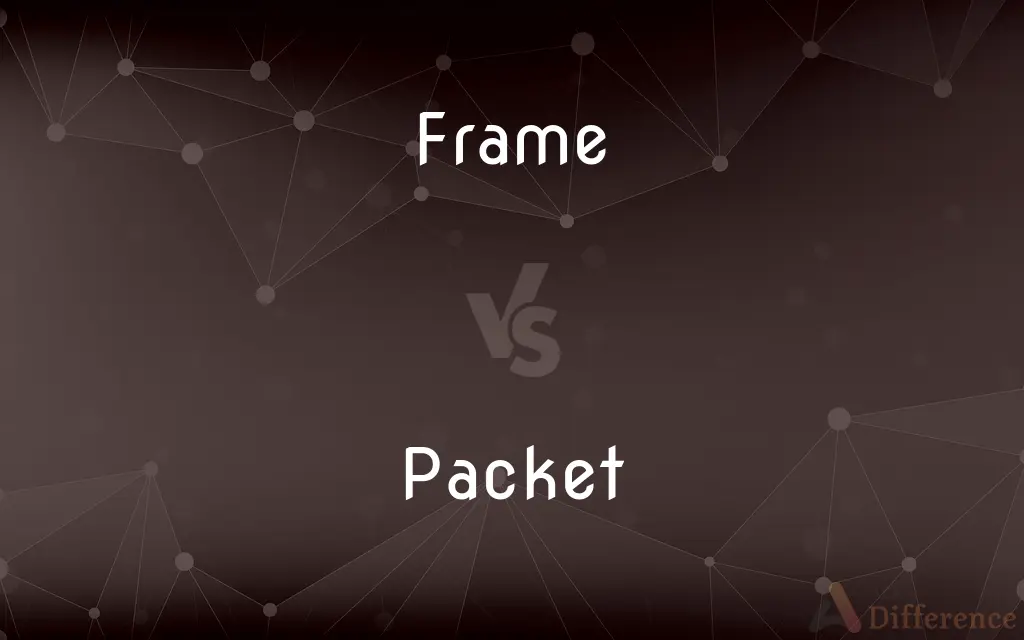Frame vs. Packet — What's the Difference?
By Tayyaba Rehman — Published on January 1, 2024
Frame is a data transmission unit at the data link layer, often containing headers and trailers for error checking. Packet is a smaller data unit at the network layer, containing routing information for data transfer.

Difference Between Frame and Packet
Table of Contents
ADVERTISEMENT
Key Differences
In networking, a "frame" is a fundamental data transmission unit at the data link layer of the OSI model. It typically consists of data, headers, and trailers. Frames serve as the packaging for data as it's sent across a local area network (LAN). These headers and trailers contain control information, source and destination addresses, and error-checking data to ensure reliable data transfer within the LAN.
On the other hand, a "packet" is a data unit used at the network layer of the OSI model. Packets are smaller than frames and contain the actual data to be transmitted along with routing information. They encapsulate data for end-to-end communication across a network, including the internet. Packets include source and destination IP addresses, which routers use to forward them to their final destination.
The key difference between frames and packets is their position in the networking stack. Frames operate at the data link layer (Layer 2), dealing with local network communication, while packets operate at the network layer (Layer 3), enabling data to traverse multiple networks. Frames are specific to the local network segment, while packets are responsible for global data routing.
Frames contain additional error-checking information like CRC (Cyclic Redundancy Check) to detect and correct errors within the local network. Packets, however, rely on higher-layer protocols (such as TCP) for error handling, as they can traverse multiple networks where errors may occur.
Comparison Chart
OSI Layer
Data link layer (Layer 2)
Network layer (Layer 3)
ADVERTISEMENT
Size
Typically larger
Typically smaller
Contents
Data, headers, and trailers
Data and routing information
Error Handling
Local error checking (e.g., CRC)
Higher-layer protocols (e.g., TCP)
Scope
Local network segment
End-to-end data transmission
Compare with Definitions
Frame
Frames play a crucial role in LANs, encapsulating data and enabling communication between devices in proximity.
Switches examine frames to forward data only to the intended recipient device.
Packet
A packet is a data unit at the network layer, containing data and routing information for end-to-end communication.
Internet packets include IP addresses to navigate through the global network.
Frame
Frames are employed at the data link layer of the OSI model, ensuring reliable data exchange in a local network.
Data frames in Wi-Fi networks contain control data for seamless wireless communication.
Packet
Packets operate at the network layer (Layer 3) of the OSI model, facilitating data transfer across diverse networks.
Packet-switched networks like the internet rely on IP packets for efficient data routing.
Frame
The frame's header includes source and destination MAC addresses, vital for data forwarding in Ethernet networks.
Routers use MAC addresses in frames to determine the next hop in a local network.
Packet
Packets encapsulate data and routing information, allowing for flexible and reliable communication over large-scale networks.
Packets in a virtual private network (VPN) maintain data security while traversing public networks.
Frame
Frame size can vary but typically includes data payload, addressing information, and error-checking data.
In token ring networks, frames have a fixed size to maintain a consistent data transmission rate.
Packet
IP packets carry data between source and destination devices, utilizing routers to navigate through interconnected networks.
Each internet packet is routed based on its destination IP address.
Frame
A frame is a data unit used in local network communication, containing data, headers, and error-checking information.
Ethernet frames facilitate data transfer within a LAN, including source and destination MAC addresses.
Packet
Packets are crucial for global data transmission, breaking down data into manageable chunks for efficient routing.
Voice-over-IP (VoIP) calls use packets to transport audio data across the internet.
Common Curiosities
What distinguishes packets from frames in terms of their scope and role in data transmission?
Frames are specific to local network segments, while packets enable data transmission across multiple networks, including the internet.
What is a frame in networking, and where does it operate in the OSI model?
A frame is a data transmission unit used in local network communication, operating at the data link layer (Layer 2) of the OSI model.
How does a frame differ from a packet in terms of size and content?
Frames are typically larger and contain data, headers, and error-checking information. Packets are smaller and contain data and routing information.
What is the primary role of frames in local networks?
Frames facilitate reliable data transfer within a local network, including tasks like addressing devices and error checking.
In which types of networks are frames commonly used for data transmission?
Frames are prevalent in various networks, including Ethernet, token ring, and Wi-Fi, to facilitate communication between devices within the same network segment.
How do frames and packets handle error checking, and where is this feature implemented?
Frames perform local error checking, typically using CRC, while packets rely on higher-layer protocols (e.g., TCP) for error handling in end-to-end communication.
Give an example of how packets are used in a specific application, such as VoIP.
Voice-over-IP (VoIP) calls use packets to transport audio data over the internet, ensuring real-time communication quality.
Where does packet data unit operate in the OSI model, and what is its primary function?
A packet is a data unit operating at the network layer (Layer 3) of the OSI model, responsible for end-to-end data routing.
What addressing information is found in a frame's header, and why is it important?
A frame's header includes source and destination MAC addresses, crucial for data forwarding within a local network.
How do packets contribute to data security in virtual private networks (VPNs)?
In VPNs, packets encapsulate data and routing information, maintaining data security while traversing public networks.
How are packets essential for internet communication, and what do they contain to achieve this?
Packets are fundamental for internet communication, carrying IP addresses that allow routers to route data across the global network.
Are frames and packets interchangeable terms, or do they have distinct roles in networking?
Frames and packets are not interchangeable; they serve distinct roles and operate at different layers of the OSI model.
Can you explain the role of packets in packet-switched networks like the internet?
In packet-switched networks, packets contain source and destination IP addresses, enabling efficient routing through interconnected networks.
What is the significance of IP addresses in packets for routing data over the internet?
IP addresses in packets are used by routers to determine the optimal path for data transmission, ensuring it reaches its intended destination.
In summary, what is the main difference between frames and packets in networking?
Frames are used for local network communication and include error-checking data, while packets operate at a higher layer, enabling data transmission across multiple networks with routing information.
Share Your Discovery

Previous Comparison
== Operator in Python vs. is Operator in Python
Next Comparison
Carbohydrates vs. ProteinAuthor Spotlight
Written by
Tayyaba RehmanTayyaba Rehman is a distinguished writer, currently serving as a primary contributor to askdifference.com. As a researcher in semantics and etymology, Tayyaba's passion for the complexity of languages and their distinctions has found a perfect home on the platform. Tayyaba delves into the intricacies of language, distinguishing between commonly confused words and phrases, thereby providing clarity for readers worldwide.
















































